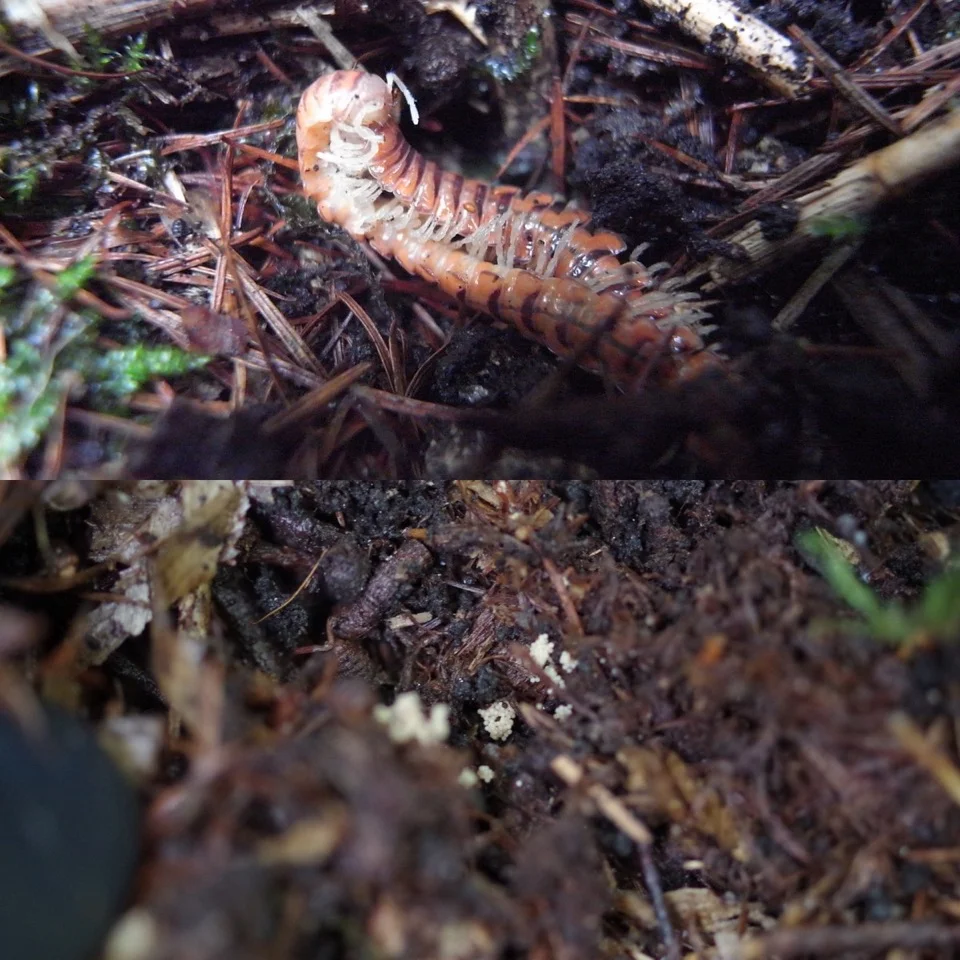The periodical millipede, Parafontaria laminata armigera
Toshio Yoshida, Professor emeritus, and Tadashi Fujikawa, Faculty of Agriculture, Shinshu University
Mating couple and eggs.
Every year in the autumn, I remember seeing swarms of many vivid colored creatures on the forest floor and their attractive “fragrance.” This “fragrance” is actually a disgusting smell for ordinary people, but it is a really impressive “fragrance” for me. This creature is relative large (c.a. 3 cm), orange with dark brown stripe millipede (Parafontaria laminata armigera (Verhoeff), Diplopoda: Xystodesmidae) and is called “the train millipede.” Most millipedes produce a defense substance with a strong odor, so any creature (or person) who grasps a millipede once is sprayed with this chemical and remembers the annoying odor! The defense chemical of Parafontaria is a type of glycosphingolipid (Mori et al., 1994, 1995: Sugita et al., 1994), and has an almond-like smell.
Train millipedes are found in the central mountains in Japan. They mostly live in forests; however, most of those forests were probably long-term grasslands before about 70 years ago. The millipedes become adults in the late summer, 7 years after being laid as an egg. The adults live to reproduce and then die in mass the following year. Surprisingly, only individuals of the same age are found in one place. Because juveniles live completely in soil (endogeic), people only notice when the adult millipedes come up on litter, swarming in September and October (new adults) and the subsequent spring every 8 years. Swarming of big populations of millipedes has been observed worldwide. However, this species has been observed to swarm at exactly eight-year intervals since 1920 in the central mountains in Japan (Niijima & Shinohara 1988). In this area, the millipede swarming is large enough to disrupt train service, so train operators keep precise records of the swarming. That’s why the millipede is called “the train millipede.”
The periodic specificity of Parafontaria millipedes make them good model organisms to study speciation (Sota and Tanabe, 2010; Tanabe et al., 2001), soil nutrient cycling (Kaneko 1999: Fujimaki et al., 2010; Hashimoto et al., 2004; Toyota et al., 2006), and effects of climate change (Makoto et al., 2014). The development of this millipede is fixed by the winter chill (Fujiyama, 1996), so any cohorts with different ages will not mate each other. For a long time, scientists could not find all the possible cohorts with different ages, but recently we found 8 different local populations, which reproduce in different years.
The largest local population of P. laminata becomes adults in 2016 in the southeast slope of Mt. Yatsugatake! Don’t you want to see the amazing swarming and try to hunt the “fragrance” this autumn? The best season will be from mid-September to mid-October.
The swarming population along a road side.
The train millipedes killed on a road.
Further Reading
Fujimaki, R., Sato, Y., Okai, N., Kaneko, N., 2010. The train millipede (Parafontaria laminata) mediates soil aggregation and N dynamics in a Japanese larch forest. Geoderma 159, 216-220.
Fujiyama, S., 1996. Annual thermoperiod regulating an eight-year life-cycle of a periodical diplopod, Parafontaria laminata armigera Verhoeff (Diplopoda). Pedobiologia 40, 541-547.
Hashimoto, M., Kaneko, N., Ito, M.T., Toyota, A., 2004. Exploitation of litter and soil by the train millipede Parafontaria laminata (Diplopoda: Xystodesmidae) in larch plantation forests in Japan. Pedobiologia 48, 71-81.
Kaneko, N., 1999. Effect of millipede Parafontaria tonominea Attems (Diplopoda: Xystodesmidae) adults on soil biological activities: A microcosm experiment. Ecological Research 14: 271-279.
Makoto, K., Arai, M., Kaneko, N., 2014. Change the menu? Species-dependent feeding responses of millipedes to climate warming and the consequences for plant–soil nitrogen dynamics. Soil Biology & Biochemistry 72, 19-25.
Mori, N., Kuwahara, Y., Yoshida, T., Nishida, N., 1994. Identification of benzaldehyde, phenol and mandelonitrile from Epanerchodus japonicus CARI (Polydesmida Polydesmidae) as possible defense substances. Appl. Entomol. Zool. 29, 517-522.
Mori, N., Kuwahara, Y., Yoshida, T., Nishida, N., 1995. Major defensive cyanogen from Parafontaria laminata armigera Verhoeff (Xystodesmidae : Polydesmida). Appl. Entomol. Zool. 30, 197-202.
Niijima, K., Shinohara, K., 1988.
Outbreaks of the Parafontaria laminata group (Diplooda: Xystodesmidae). Jpn. J. Ecol. 38, 257-268.
Sota, T., Tanabe, T., 2010. Multiple speciation events in an arthropod with divergent evolution in sexual morphology. Proceedings of the Royal Society B-Biological Sciences 277, 689-696.
Sugita, M., Hayata, C., Yoshida, T., Suzuki, M., Suzuki, A., Takeda, T., Hori, T., Nakatani, F., 1994. A novel fucosylated glycosphingolipid from the millipede, I. Biochimica Et Biophysica Acta-Lipids and Lipid Metabolism 1215, 163-169.
Tanabe, T., Katakura, H., Mawatari, S.F., 2001. Morphological difference and reproductive isolation: morphometrics in the millipede Parafontaria tonominea and its allied forms. Biol. J. Linn. Soc. Lond. 72, 249-264.
Toyota, A., Kaneko, N., Ito, M.T., 2006. Soil ecosystem engineering by the train millipede Parafontaria laminata in a Japanese larch forest. Soil Biology and Biochemistry 38, 1840-1850.



